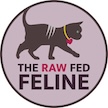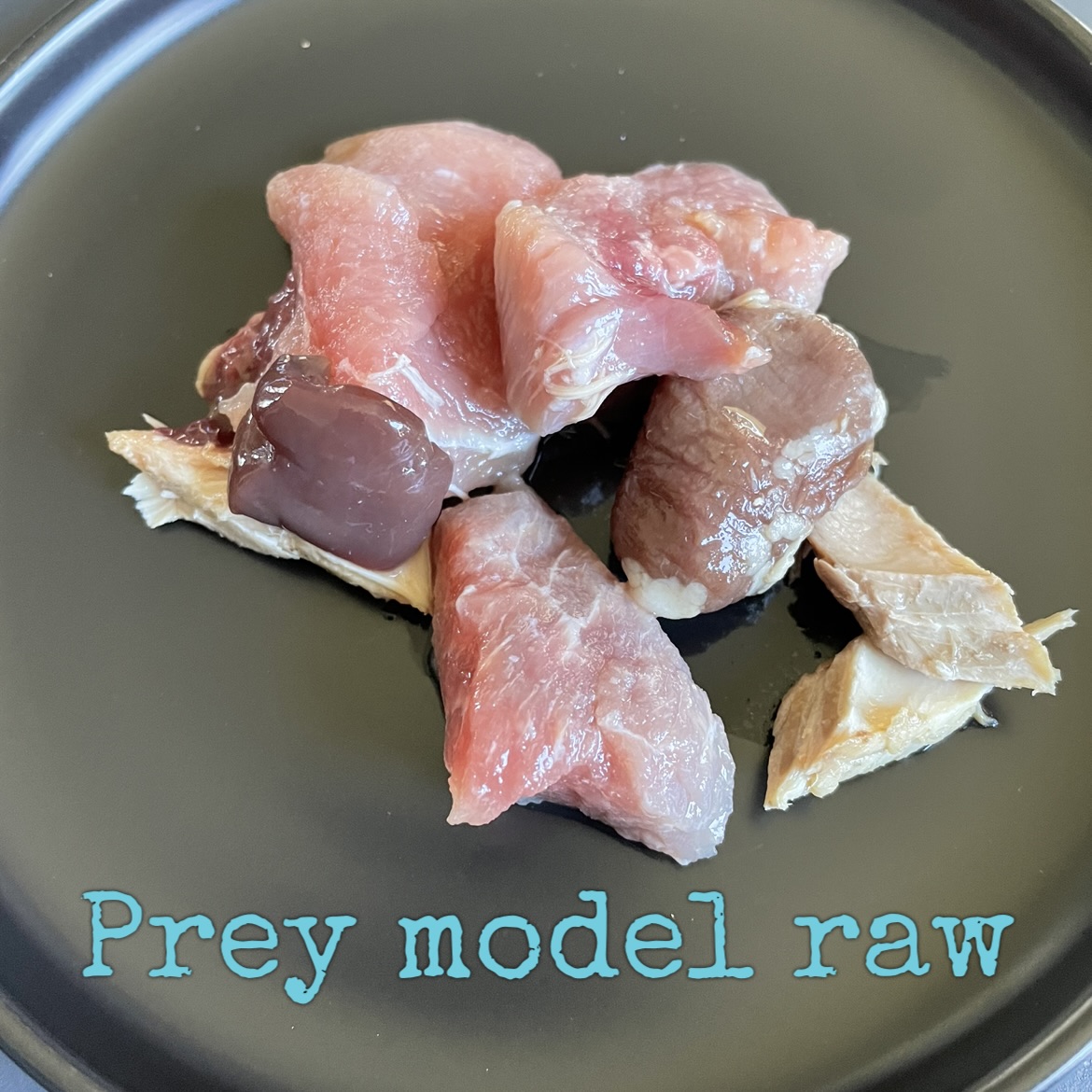If using a meat completer is like using a box of cake mix, then feeding prey model raw (PMR) is like making the cake from scratch. It can be very fun and rewarding for those who like making food. Prey model raw, referred to as PMR, means feeding different parts of animals in ratios to approximate whole prey. You will also see PMR+. The + means that nutritional gaps will be addressed in the diet through supplementation in some form. These gaps exist because whole prey is so much more than just a ratio of meat, bone, and liver.
Ratios: PMR
The ratio of meat/bone/organs is the foundation of the PMR diet. A commonly used ratio for cats is 84% muscle meat, 6% edible bone, 5% liver, and 5% other secreting organ (84/6/5/5). Most cats respond well to a bone ratio in the range of 5-8%. Cats’ natural prey has bone content within that range. For example, mice and rats both have approximately 5% bone. You will often see a ratio of 80/10/10 in regards to PMR and in commercial raw foods, which is the standard for dogs, although some cats can tolerate 10% bone just fine.
PMR is often fed in whole pieces, but you can also feed PMR ground, if that is what works best for your cat.
Variety
A crucial element of feeding PMR is variety. A variety of muscle meats, organs, and bones is very important to make sure your cat is getting a wide array of macro and micro nutrients. You can mix and match different parts of animals in one meal. For example, turkey thigh/chicken wingtip/beef liver/pork kidney. Rotate as many different sources of meat, bone, and organ as you can. Most sources recommend feeding a minimum of 3 different proteins when raw feeding. However, when feeding PMR, more is definitely better. Aiming for 5-7 proteins would be better than the minimum of 3. Including at least 50% red meats in the diet is also encouraged.
meat & muscular organs
You want to include a variety of red/white and fat/lean meats. Some examples of meat to feed include chicken, turkey, beef, pork, venison, bison, emu, duck, elk, pheasant, quail, rabbit, lamb, goat, kangaroo, and any other meats your cat might like. You do not want to feed other carnivores due to issues with biomagnification. Freeze any wild game and fish for at least 3 weeks to kill parasites. See my previous post about feeding raw safely for more information about knowing where your meat comes from and safe freezing and thawing.
There are certain organs that are classified as muscular organs that are also fed as part of the meat portion. Muscular organs include hearts, tongue, lungs, gizzards, and tripe. They can account for 20% of the total of the 84% of meat. Hearts are an important source of taurine and should be included regularly in the diet. I include hearts in every batch of Hazel’s food for taurine.
Raw meaty Bones
Edible bones should always be fed raw. Raw bones are softer and more pliable. Cooked bones splinter and should never be fed. You want to use size appropriate bones for cats, such as chicken wingtips, wingettes or flats that can be cut in half lengthwise, chicken and duck toes, chicken and rabbit ribs, smaller rabbit bones, Cornish hen, quail, and on occasion, chicken necks (necks can have thyroid tissue on them, which you don’t want to overfeed).
You want to consider not only the size of the bone, but also the bone density. Bones that are too dense will have an increased risk of chipped teeth. Any weight bearing bones or bones from large animals should not be fed whole, only ground. When you are choosing whole bones to feed your cat, keep a mouse in mind, their bones are both light and small.
Raw meaty bones have both meat and bone that need to be accounted for in regards to the ratio. If you need 6% bone, you need to determine how much actual bone is in the raw meaty bone that you are using. For example, chicken rib cages are approximately 80% bone and 20% meat. This is an easy calculator to help figure out how much of a raw meaty bone you need to include to provide 6% bone for your cat.
organs
Liver is generally fed between 2-5% of the diet. Livers from ruminant animals should be fed closer to 2-3%. Poultry livers can be fed at 5%, with the exception of duck liver, which is extremely high in vitamin A. Duck liver should be fed only sparingly and at 2-3% like ruminant livers. Vitamin A is a fat soluble vitamin, so you do not want to over supplement it in the diet. Try to use livers from different animals, such as chicken, beef, lamb, goat, turkey, etc., if possible. A variety of liver is important as the livers from different animals have different nutrient profiles, although they are all a major source of vitamin A in a raw diet.
Secreting organs other than liver make up the other 5-8%. Secreting organs include kidneys, spleen, pancreas, thymus, testes, ovaries, and brains. In keeping with the importance of nutrient variety, you want to aim to use as many different secreting organs in rotation as you can.
Secreting organs can be hard to source, depending where you live. Asian and other ethnic markets are amazing sources for organs. Another option would be to use freeze dried organ meat if you can’t find a source of fresh organs. Freeze dried and fresh are not a 1:1 swap. This is a handy calculator to help figure out how much freeze dried you would use. If you are unable to source any second secreting organs at all, then additional supplementation would be necessary to provide the nutrients missing from the lack of a second secreting organ in the diet.
additional ingredients
Whole raw eggs or egg yolks are included in the diet as they are a source of many important nutrients. Quail, chicken, and duck eggs are all good options. Typically 1 egg per pound of food is added (3-5 quail eggs=1 chicken egg).
Adding a source of omega-3 fatty acids is important as well. This can easily be provided by including small oily fish or a fish oil. Sardines, herring, mackerel, and smelt are a few oily fish that can be fed. Add fish oils at the time of serving. You don’t want to mix them in or freeze in a batch of food. Oils can go rancid quickly when exposed to air, light, and heat.
When you include a source of fatty acids in the diet, you should also include vitamin E. Vitamin E is a powerful antioxidant and protects the fragile fatty acids from oxidative damage. Vitamin E can be provided in the form of an oil or powder supplement.

filling in the gaps “+”
Since you are not truly feeding the whole animal, which would include fur, feathers, eyes, blood, etc., there are several common nutritional gaps in a ratio diet. These gaps can include iodine, manganese, B vitamins, zinc, and iron. You can use individual supplements or whole food sources. Here are some ways to provide these nutrients in a PMR+ diet:
Iodine: kelp, iodized salt
Manganese: blue mussels, tripe
B vitamins: pork, beef kidney, organ meats, nutritional yeast
Zinc: oysters, red meats
Iron: spleen, blood, red meats
See this article for more information on specific amounts to feed of these nutrients.
The key with PMR is variety and rotation. I can’t stress this enough. You do not have to calculate every nutrient in this method of feeding, but you do need to be aware of what is needed and be mindful of providing a wide variety in the diet. This practice allows for balance to be provided over time, much in the same way as you probably eat. Personally, I don’t calculate exactly how much vitamin C I need daily, but I am mindful to eat a variety of whole foods that provide vitamin C in my diet.
Figuring it out: PMR
My previous post covered how to figure out how much raw food to feed your cat. You need your cat’s weight to figure out how much meat, bone, and organs are needed.
For example: say you have an 8 lb adult cat who is moderately active—you would first change her weight in pounds to weight in ounces, so 8 X 16 (because there are 16oz in a pound)=128oz. Starting with 3% to feed, you would take 128 X 3%=3.84oz per day of raw food is needed for this cat. You can decide if you want to make food daily, weekly, or monthly, it’s just personal preference.
In this example, we will figure out amounts for a week. We can do this by taking 3.84oz X 7 days=26.88oz of food per week. You can round up to 27oz for the sake of your own sanity. Let’s figure out the ratios for the week:
27oz X 84%=22.68 meat
27oz X 6%=1.62 bone
27oz X 5%=1.35 liver
27oz X 5%=1.35 other secreting organ
You will need to have a small digital scale, but you can round things to make it a bit simpler, so 23oz of meat, 1.5-2oz of bone, 1.5 oz of liver and other organ would be just fine.
There are formulators or spreadsheets that you can purchase to use if you prefer. It can seem overwhelming at first, but once you have your initial ratios figured out, it’s gets easier. Then it’s about mixing and matching combinations of meats, bones, and organs to provide that all-important variety in your cat’s diet.

Balance over time
You can balance your adult cat’s meals over time, usually over a week, or offer a completely balanced meal each time. Growing kittens need complete nutrition more frequently in the diet than adult cats. There is a bit of trial and error to see what works for you and your particular set up. Freezer space & containers are important considerations as well and will determine how large of batches of food you can make at one time.
Feeding PMR usually feels overwhelming at first, I started and stopped three times before I really felt comfortable feeding this way. But once you figure out the numbers and how to provide variety, it can be a really fun way to feed your raw fed feline!


